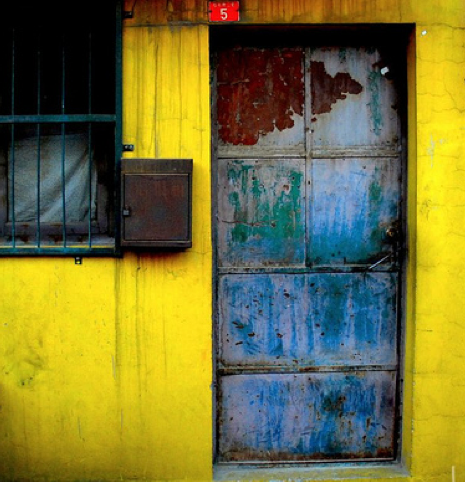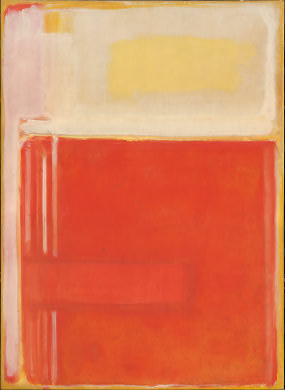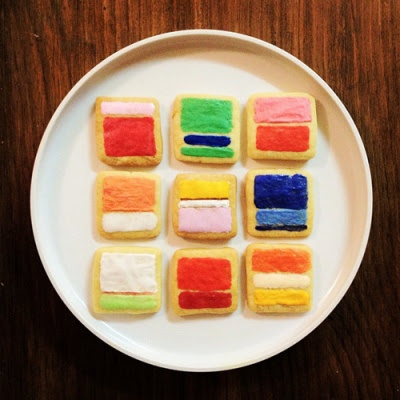Rothko Streetwise
part 2.

It's ironic that within our city streets and small towns there are hidden ROTHKO'S waiting to be discovered. Here are examples of ROTHKO'S hidden in plain site. Back alleyways, painted buildings, underpasses,tucked away corners, these seemingly unassuming architectural structures hide Rothko-esc arrangements of color and shape somehow created through years of constant change within our urban environments. These unintentional plays of color without thought to the aesthetics where developed by the elements in urban construction patinated by nature
and time.
Consider the irony of something that has been accidentally created by dozens of people over several decades, ending up closely resembling the "very intentional" compositions of abstract expressionist, Mark Rothko. While these gems can be found in our streets, Rothko's paintings hang in museums and private collections throughout the world / price tag of $80 million. So, next time you pass by downtown, keep a look out for a ROTHKO. Make sure to shoot it and save it, before it vanishes.


by Alan Ota
by Alan Ota
by Alan Ota
by Alan Ota
by Alan Ota
Brooklyn Rec Center, locker room shower.
BREADKO
LOGOKO
special thanks to Alan Ota for his cool photography.
CHEERS.
_____________________________________________________________
CHEERS.
_____________________________________________________________
Mark Rothko
b. 1903, Dvinsk, Russia; d. 1970, New York
part 1.
Mark Rothko was born Marcus Rothkowitz on September 25, 1903, in Dvinsk, Russia. In 1913 his family left Russia and settled in Portland, Oregon. Rothko attended Yale University, New Haven, on a scholarship from 1921 to 1923. He left Yale prematurely and moved to New York. In 1925 he studied under Max Weber at the Art Students League. He participated in his first group exhibition at the Opportunity Galleries, New York, in 1928. During the early 1930s Rothko became a close friend of Milton Avery and Adolph Gottlieb. His first solo show took place at the Portland Art Museum, Oregon, in 1933.
Rothko’s first solo exhibition in New York was held at the Contemporary Arts Gallery in 1933. In 1935, together with William Baziotes, Gottlieb, and others, Rothko founded the Ten, a group of artists sympathetic to abstraction and expressionism that exhibited until 1940. He executed easel paintings for the Works Progress Administration Federal Art Project from 1936 to 1937. By 1936 Rothko knew Barnett Newman. In the early 1940s he worked closely with Gottlieb, developing a painting style with mythological content, simple flat shapes, and imagery inspired by so-called primitive art. By mid-decade his work incorporated Surrealist techniques and images. Peggy Guggenheim gave Rothko a solo show at Art of This Century, New York, in 1945.
In 1947 and 1949 Rothko taught at the California School of Fine Arts, San Francisco, where Clyfford Still was a fellow instructor. With Baziotes, David Hare, and Robert Motherwell, Rothko founded the short-lived school Subjects of the Artist, New York, in 1948. The late 1940s and early 1950s saw the emergence of Rothko’s mature style, in which frontal, luminous rectangles seem to hover on the canvas surface. In 1958 the artist began his first commission, monumental paintings for the Four Seasons Restaurant, New York. The Museum of Modern Art, New York, gave Rothko an important solo exhibition in 1961. He completed murals for Harvard University, Cambridge, Massachusetts, in 1962 and in 1964 accepted a mural commission for an interdenominational chapel in Houston. Rothko committed suicide on February 25, 1970, in his New York studio. A year later the Rothko Chapel in Houston was dedicated, and in 1978, the Guggenheim Museum organized a major retrospective.
The Seagram Murals.
In the late 1950s, Rothko was commissioned to create a series of paintings for the new Four Seasons restaurant in New York. These paintings were to become the aforementioned Seagram Murals. While on trip to Florence he gained inspiration for the series from the San Lorenzo library’s Michelangelo Room, and said that the “room had exactly the feeling that I wanted [...] it gives the visitor the feeling of being caught in a room with the doors and windows walled-in shut.” Again, it was clear that he intended his paintings to have a very physical effect on viewers, and also it was clear that he wasn’t really keen on making “nice” paintings as part of a restaurant backdrop. Indeed, in the end Rothko pronounced the Four Seasons to be pretentions and inappropriate to display his work, and as such he never completed the project. The paintings he’d created towards it were never hung in the restaurant.
ps. SEE THIS DOCUMENTARY. It's EYE-LIKEY RECOMMENDED.
LOVED IT.
London’s Whitechapel Gallery has recently opened a 2ndMark Rothko exhibition. The last time the artist showed here was way back in 1961, when visitors were stunned by this new artist with the ability to provoke such intense emotional feeling via his huge abstract paintings. Nowadays, Rothko’s paintings are no less deep in their effect. The Tate Britain displays its permanent collection of his works, part of the Seagram Murals series. These paintings are so large that they still look huge on the walls of this industrial- scale building. The grey walls and low lighting complete the impact of the works. For the original Whitechapel Gallery exhibition, Rothko gave specific instructions as to how work was to be hung and how the room was to be lit, demonstrating that he was very aware of the physical effects of his work on the viewer.
Rothko in his studio, East Hampton, NY 1964
Have a cookie.






















































































